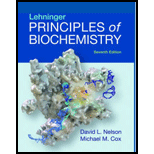
Concept explainers
(a)
To explain: The way in which the given information can be used to determine the number of polypeptide chains in an oligomeric protein.
Introduction:
Proteins are the basic building blocks of human body as it is required for growth and development. As it serves as an essential nutrient in the human body, it helps in the formation of body tissue. The proteins are formed by repeated linkage of amino acids through peptide bonds. The amino acids have “carboxyl group”, “amino group” and “R group”. The two amino acids are joined by peptide bond, such that the carboxyl group of one amino acid reacts with amino group of another amino acid. This result in formation of peptide bond and water molecule is lost.
(b)
To calculate: The number of polypeptide chains in the given protein.
Introduction:
The basic building block of human body is protein as it is required for growth and development. As it serves as an essential nutrient in the human body, it helps in the formation of body tissue. The proteins are formed by repeated linkage of amino acids through peptide bonds. The amino acids have “carboxyl group”, “amino group” and “R group”. The two amino acids are joined by peptide bond, such that the carboxyl group of one amino acid reacts with amino group of another amino acid. This result in formation of peptide bond and water molecule is lost.
(c)
To determine: The other analytic technique that could be used to decide whether the polypeptide chains in the given protein are similar or different.
Introduction:
Proteins are the basic building blocks of human body as it is required for growth and development. As it serves as an essential nutrient in the human body, it helps in the formation of body tissue. The proteins are formed by repeated linkage of amino acids through peptide bonds. The amino acids have “carboxyl group”, “amino group” and “R group”. The two amino acids are joined by peptide bond, such that the carboxyl group of one amino acid reacts with amino group of another amino acid. This result in formation of peptide bond and water molecule is lost.
Want to see the full answer?
Check out a sample textbook solution
Chapter 4 Solutions
Lehninger Principles of Biochemistry
 BiochemistryBiochemistryISBN:9781319114671Author:Lubert Stryer, Jeremy M. Berg, John L. Tymoczko, Gregory J. Gatto Jr.Publisher:W. H. Freeman
BiochemistryBiochemistryISBN:9781319114671Author:Lubert Stryer, Jeremy M. Berg, John L. Tymoczko, Gregory J. Gatto Jr.Publisher:W. H. Freeman Lehninger Principles of BiochemistryBiochemistryISBN:9781464126116Author:David L. Nelson, Michael M. CoxPublisher:W. H. Freeman
Lehninger Principles of BiochemistryBiochemistryISBN:9781464126116Author:David L. Nelson, Michael M. CoxPublisher:W. H. Freeman Fundamentals of Biochemistry: Life at the Molecul...BiochemistryISBN:9781118918401Author:Donald Voet, Judith G. Voet, Charlotte W. PrattPublisher:WILEY
Fundamentals of Biochemistry: Life at the Molecul...BiochemistryISBN:9781118918401Author:Donald Voet, Judith G. Voet, Charlotte W. PrattPublisher:WILEY BiochemistryBiochemistryISBN:9781305961135Author:Mary K. Campbell, Shawn O. Farrell, Owen M. McDougalPublisher:Cengage Learning
BiochemistryBiochemistryISBN:9781305961135Author:Mary K. Campbell, Shawn O. Farrell, Owen M. McDougalPublisher:Cengage Learning BiochemistryBiochemistryISBN:9781305577206Author:Reginald H. Garrett, Charles M. GrishamPublisher:Cengage Learning
BiochemistryBiochemistryISBN:9781305577206Author:Reginald H. Garrett, Charles M. GrishamPublisher:Cengage Learning Fundamentals of General, Organic, and Biological ...BiochemistryISBN:9780134015187Author:John E. McMurry, David S. Ballantine, Carl A. Hoeger, Virginia E. PetersonPublisher:PEARSON
Fundamentals of General, Organic, and Biological ...BiochemistryISBN:9780134015187Author:John E. McMurry, David S. Ballantine, Carl A. Hoeger, Virginia E. PetersonPublisher:PEARSON





